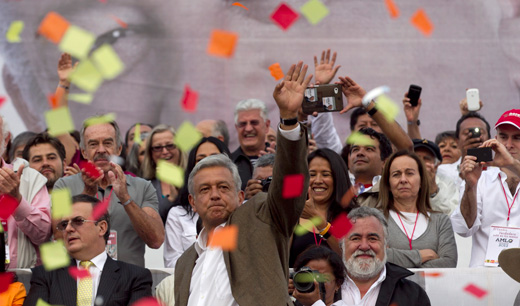
Official results of Sunday’s Mexican elections will not be released until July 4, but it appears that the candidate of the formerly dominant Revolutionary Institutional Party (PRI), former Mexico state governor Enrique Peña Nieto, has won, but not by as much as he hoped.
His handlers had been saying he would win by a margin of two digits, but unofficial results show him with 38 percent of the vote, just 6 percentage points ahead of the 32 percent that went to former Mexico City Mayor Andres Manuel Lopez Obrador, the candidate of the left-wing alliance based on the Revolutionary Democratic Party (PRD).
Josefina Vazquez Mota, the candidate of current president Felipe Calderon’s right-wing National Action Party (PAB), trailed with 25 percent of the vote, and a fourth candidate, Gabriel Quadri of the National Alliance, got a negligible vote, between 2 and 3 percent.
In one piece of good news for the left, the PRD candidate for the mayoralty of Mexico City (technically, for governor of the Federal District which includes the capital), Miguel Angel Mancera, absolutely trounced his PRI, PAN and other rivals with a record 60 percent majority.
Mexico City has been governed by left-wing mayors since the post became elective in 1997, and has come to be seen as an oasis of dropping crime rates and relatively efficient administration in a country wracked by drug violence. Mancera is currently the attorney general of the Federal District.
Overall, it appears the PRI did well in legislative, gubernatorial and local races as well, mostly at the expense of the right-wing PAN, which is blamed by voters for economic stagnation and, above all, the bloodshed of the drug war which has claimed over 55,000 lives in just a few years.
How the new Congress will stack up will not be known precisely until official results are published. Mexico uses a proportional representation system. Of the 500 seats in the Chamber of Deputies, the lower house of Mexico’s Congress, 300 are filled directly on Election Day, and another 200 are assigned to political parties roughly in proportion to the vote they got nationally. In the 160-seat Senate, 128 are elected directly and 32 are assigned by the proportional representation method.
Vazquez and Quadri conceded but Lopez Obrador said in a Monday evening press conference that he was not going to concede until he got some answers about electoral fraud. He made clear that he may well launch a legal challenge about the results. After a squeaker of an election in 2006, in which Lopez Obrador was inched out by Calderon, Lopez Obrador and his followers organized large-scale demonstrations in Mexico City.
A number of cases seeming to prove manipulation of election results by personnel of the Federal Elections Institute (IFE) have been circulating via Facebook and Twitter. These include evident major changes to vote totals from handwritten records of the polling places to the official website of the IFE, sometimes radically increasing the vote for the PRI and sometimes reducing the vote for the PRD. In one case, the 81 votes for the PRI recorded at a polling place turned into 801 votes by the time the information was posted on the IFE website.
There were also numerous allegations of vote-buying by the PRI. In a comic interlude, a crowd of people carried on a demonstration outside the PRI headquarters in Mexico City’s Azcapotzalco neighborhood. They were not protesting fraud; they were complaining that the PRI had promised them money in exchange for their votes, but had stiffed them!
But the major fraud was seen as coming in the lead-up to the elections. Mexican law is strict on how electoral campaigns must be run and financed. But by the beginning of the campaign, suspicions began to arise of collusion between the privately owned media, especially two television channels, Televisa and TV Azteca, and the PRI’s electoral machinery, specifically that they were deliberately building up Peña Nieto and undermining the opposition in their supposedly objective news coverage. Evidence to support this suspicion came with an exposé by the British newspaper The Guardian that in fact the PRI had, since the last election campaign in 2006, been giving Televisa money in exchange for undermining the candidacy of Lopez Obrador, a direct violation of Mexican election law.
The perception that Peña Nieto was a manufactured candidate being foisted on the Mexican electorate by over-powerful and corrupt media monopolies helped to spark a large scale uprising of youth, who carried out a campaign against Televisa and against Peña Nieto through demonstrations and social media. This “I am number 132” campaign made a palpable difference in the actual election, helping at least to narrow the distance between Peña Nieto and Lopez Obrador.
The angry youth demonstrated against what they consider the manipulated results of the election again on Monday, with more protests planned.
Photo: Andres Manuel Lopez Obrador, presidential candidate for the Democratic Revolution Party (PRD) waves at supporters during the closing rally of his campaign at the main Zocalo plaza in Mexico City, June 27. Esteban Felix/AP









